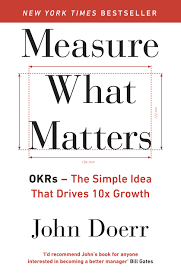“Measure What Matters: OKRs” is considered one of the best books on OKRs (Objectives and Key Results) and often ignored CFRs (Conversations, Feedback, Recognition). The book is written by John Doerr, a venture capitalist who introduced OKRs to Google in 1999.

The book explains how OKRs (and CFRs) a strikingly simple method, can be used to set ambitious goals and align teams to achieve them. It provides a step-by-step guide on how to implement OKRs and covers best practices, case studies along with lessons learned from successful companies that use OKRs such as Google, Intel, and the Bill and Melinda Gates Foundation.
It covers all the aspects of OKRs, such as:
- How to set effective objectives that are Specific, Measurable, Achievable, Relevant and Time-bound (SMART)
- How to set and align team goals with company objectives
- How to use OKRs to drive performance, innovation and growth
- How to use data and metrics to track progress and measure success
- How to use OKRs to align teams, departments and organizations
- The role of CFRs in the process
The book also includes tools and templates that can be used to implement OKRs, making it a practical guide for managers, leaders and teams. It’s a simple read, easy to follow and has a lot of real-world anecdotes and examples, making it a valuable resource for anyone who wants to implement OKRs in their organization.
John Doerr also introduced a companion to OKRs called CFRs, this part is usually ignored by organizations trying to implement OKRs even though it is an integral part towards an effective implementation.
CFRs, Conversations, Feedback, and Recognition. CFRs give the rather binary grading of OKRs the necessary layer and context to achieve effective continuous performance management. This essay on “Measure what matters” website gives clear explanation of continuous conversations, giving feedback and importance of appreciation and recognition of team members.
Beware of the Common pitfalls when implementing OKRs:
-
Ignoring CFRs part altogether
-
Treat OKRs like KPIs
-
Link OKRs to an annual performance appraisal and to salary evaluation
-
Confuse Key Results for actions, projects, or initiatives
-
Mandate OKRs top-down as cascading commands
-
Ignore stretch goals and objectives or treat all objectives as attainable
The book and the website provide complete guide on implementing OKRs and CFRs effectively.
OKRs (and CFRs) is undoubtedly The simple idea that drives 10X growth.
Leave a Reply